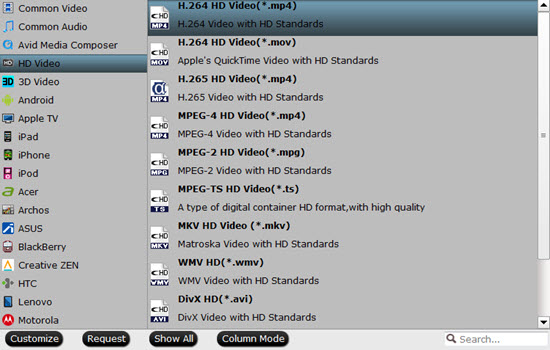Vimeo has become more and more popular among those people who like sharing their favorite movies/videos and recorded videos in Summer by high-definition (HD) digital camcorders such as Sony A6300, Sony RX10 III, Canon XC10, GoPro Hero 4 etc. And a wide range of file formats are accepted by Vimeo, such as ASF, ASX, AVI, DivX, DV, DVX, M4V, MOV, MP4, MPEG, MPG, QT, WMV, 3G2, 3GP, 3ivX,3VX and so on. It’s amazing that Vimeo attracts 65 million unique visitors per month and more than 8 million registered users. According to the latest news, you can share your videos straight to Vimeo from both Photo Gallery and Movie Maker. Once you have your project saved and are ready to share it with the world, just click on the Vimeo button in the share gallery, choose from a variety of options that Vimeo provides and you’re done. 
However, it is still a problem when people want to upload MTS/M2TS to Vimeo. Because MTS/M2TS file format can not be recognized by Vimeo. M2TS to Vimeo Converter software is specially designed for Vimeo fans.
With M2TS to Vimeo converter software, users not only can convert M2TS videos to Vimeo, but also can convert any other videos to Vimo suppported video formats. Except that, its multiple editing functions are poweful.
So here we provide you two methods to convert your Summer MTS/M2TS videos to Vimeo supported format like MP4
Part 1. Convert MTS/M2TS to MP4 with HandBrake for Vimeo
Note: With HandBrake, you can only convert the MTS or M2TS video to MP4 or MKV. If you want to do more with your cam video, go to Part 2.
Guide to convert AVCHD MTS/M2TS video to MP4 for Vimeo with HandBrake
Step 1. Download HandBrake to convert your MTS/M2TS video
Step 2. Add your MTS/M2TS files to the Mac app. After the launch of HandBrake, you’ll see the import window, where you can choose your MTS/M2TS file to add. Only one file can be imported at a time. If you want to perform batch conversions, try a HandBrake alternative instead. If there is no import window shown up, you can click “Source” at the top left corner of the main interface to open it, or you can also click the “Browse” button to find your file to convert.
Step 3. Set the output format. Under the Output Settings section in the middle of the main interface, click the format box to choose MP4 or MKV to be your output format. After that, adjust your output video settings by clicking the proper tab on the bottom of the interface. If you want to customize the picture settings, click the picture settings icon at the top right corner.
Step 4. Start to convert MTS, M2TS with HandBrake. Now, at the top left corner, click the “Start” button to convert MTS or M2TS with your HandBrake. You can add more files to the converting queue by clicking the “Add to Queue” button.
Part 2. Convert MTS/M2TS to MP4 and other formats for Vimeo
Main Features of the best MTS to MP4 Converter
- Convert MTS/M2TS to MP4 to play MTS/M2TS in iTunes, iPad, iPhone, iPod, Samusng, PSP, PS3, PS4, Xbox 360, Smart TV etc
- Convert MTS/M2TS to MP4 to play MTS/M2TS in QuickTime or edit MTS/M2TS in iMovie and Final Cut Pro, Premiere Pro, FCP X, FCP 6/7, FCE, iMovie, Apple Aperture 3, Avid Media Composer, Windows Movie Maker, Sony Vega Pro etc.
- Convert MTS/M2TS to MP4 to play MTS/ M2TS in Android, BlackBerry, Xbox 360, PS3, PS4, Plex, Windows Phone, Samsung Galaxy, portable media player and more;
- Convert MTS/M2TS to MP4 to upload MTS/M2TS to some video websites like Vimeo, YouTube, Facebook, Instagram, etc to share your video with your friends, family and more people;
- Convert MTS/M2TS to MP4 while optimize MTS/M2TS like trim, crop, merge, rotate, add effect/subtitle/watermark/background music, change audio channel, adjust volume/bitrate, remove subtitle, etc;
- Also supports converting MTS/M2TS to almost all other popular video formats like MP4, H.265, AVI, WMV, MOV, MKV, FLV, ASF, WebM, DV, RM, 3GP and more;
- Besides, it enables to extract audio from MST/M2TS to save as MP3, WAV, AAC, AC3, M4A, ALAC, AIFF, CAF, DTS, AU, etc.
- Fully compatible with Mac OS X 10.11 El Capitan, Mac OS X 10.10 Yosemite, 10.9 Mavericks, 10.8 Mountain Lion, 10.7 Lion, 10.6 Snow Leopard, 10.5 Leopard.
- (Pavtube MTS/M2TS Converter) Fully compatible with Windows 10, Windows 8.1, Windows 8, Windows 7, Windows XP
Make preparation: First free download and install this ideal MTS to MP4 Converter on your Mac or PC, and then follow the tutorial to convert MTS/M2TS to MP4 for Vimeo smoothly.


Other Download:
- Pavtube old official address: http://www.pavtube.com/mts-converter-mac/
- Amazon Download: http://www.amazon.com/Pavtube-MTS-M2TS-Converter-Download/dp/B00QIE3U0Y
- Cnet Download: http://download.cnet.com/Pavtube-MTS-M2TS-Converter/3000-2194_4-76177029.html
Convert MTS/M2TS to MP4 format for Vimeo with Pavtube MTS/M2TS Converter
Step 1. Import MTS/M2TS to the program
Click “Add File” button of this MTS to MP4 Converter to import MTS/M2TS files to the program. It also allows you to drag and drop MTS/M2TS file to the main interface to load MTS/M2TS in double-quick time.
Tips: This App supports to batch convert MTS/M2TS files. Just drag and drop the folder where MTS/M2TS files are to the interface of the software and then follow step 2 and step 3, and you will convert MTS/M2TS to MP4 in batch mode.
Step 2. Set MP4 as output format
Click “Format” drop-down button of this program to select “MP4 (*.mp4)” as output format from “Common Video” category. If you wan to play them on more HD media players (select HD MP4 from HD Video or 3D VR headsets (select 3D MP4 from 3D) and more MP4 output formats. Choose the output formats as you desire from different categories for different devices and players.

Step 3. Convert MTS/M2TS to MP4
Click “Convert” button to start converting MTS/M2TS to MP4 right away. Check “Output to the Source Folder” on the bottom right of the program and the converted MP4 file will be saved to the folder where the source MTS/M2TS clips are.
How to Upload the video to Vimeo with 6 steps?
Step 1: Log Into Your Account
The first thing that you should do is visit the Vimeo website. If you already have an account, log into it by clicking the login link. If you don’t have an account, then you will need to register. Follow the instructions and enter the necessary information to create your account.
Step 2: Uploading the Video
Click the “Upload Video” button which is located on the home page of the site. You will also be able to find the same link in the navigation bar which is under the Upload heading.
Step 3: The Upload Page
Once you click the upload link, you will be taken to the upload page. This can be confusing at times. You need to read through this and follow the directions. You will need to ensure that you are permitted to upload the videos you are interested in.
You will only be able to upload videos that you create yourself. It’s not possible to upload any videos that are copyrighted or owned by anyone else.
Step 4: Selecting the File
Click the “Choose a File to Upload” button and this will launch an upload dialog box. Choose the file that you want to upload and then click on “Select”. As soon as you click the button, the video will start to be uploaded straight away. The progress bar should estimate how long the video will take to be uploaded.
If you are using a slow Internet connection, then you will find it takes longer to upload. Just be patient and allow the video to be fully uploaded. If there are any problems with the uploaded video, then you will need to repeat the process and upload it a second time.
Step 5: Conversion
As soon as the video is uploaded, the video will then be converted automatically. You can close this page if you want, and Vimeo will handle the conversion automatically. Once the video has finished converting, the service will then email you once the conversion has finished.
Step 6: Using the Desktop Uploader
If you are interested in uploading lots of files, then you will need to use the desktop uploader. This is optional, but will make uploading files much simpler.
Click the download button to download the uploader to your computer. Accept the license details, and save the file on your computer. Follow all the instructions to install the application on your computer. This will then walk you through the process of uploading files to the service.
Uploading / Conversion Problems – Soled!
I am having trouble uploading a video! What should I do?
If you’re having trouble uploading videos to Vimeo, here are some things you might want to try:
Test your upload speeds using this speed test to ensure you’re getting the speeds promised by your ISP
Disable any browser extensions or ad-blocking software
Update your browser to the most recent version
End or pause any activities on your network that might be consuming bandwidth (Netflix, online games, other uploads or downloads, etc.)
Wait a few minutes and then try uploading again
You’ve asked me to disable browser extensions, how do I do that?
We all love browser extensions — they can add much needed functionality and make our days more enjoyable and productive. However sometimes these extensions (also known as “add-ons”) can interfere with the way a website is designed to work. Rude. The Staff may ask you to temporarily disable extensions when troubleshooting, in case they’re the cause of any issues. Take a look at the respective article below for instructions on how to do this in your browser.
Google Chrome
Safari
Firefox
Internet Explorer
I uploaded a 16:9 (widescreen) video but Vimeo squished it to 4:3, what gives?
Vimeo uses square pixels when converting your video. You will need to export your videos with square pixels and manually set your aspect ratio to 853×480 for widescreen DV, or 1280×720 for high definition. Read our Compression Guidelines for more information.
Does Vimeo throttle upload speeds?
No, Vimeo does not limit your uploading speed in any way — we take as much bandwidth as your Internet Service Provider will allow.
The only limit on uploads is your weekly quota. (For example, Plus members can upload up to 5GB per week.)
Why is my video taking so long to upload?
In general, the amount of time it takes to upload a video to Vimeo is outside of our control. We do not limit our members’ upload speeds — we take as much bandwidth as your Internet Service Provider (ISP) will allow. If your upload is slower than expected, it could be due to multiple factors, including:
Lower overall upload speeds provided by your particular Internet plan
Time of day / peak hours of usage with your Internet Service Provider (ISP)
Increased traffic on your local network
Incorrect network, firewall, or router settings
When testing your upload speeds, keep in mind that online “speed tests” are not always accurate. The results you receive from these tests may be skewed by the location of the test server, as well as the factors listed above.
Why has the end of my video been cut off?
When a video appears to be “cut off” on Vimeo, it is usually due to some kind of corruption with the source file. To start, try watching your original source file on your computer (in a program like Quicktime or VLC) to ensure that it plays back without issue. If everything looks good, re-upload the file and see whether the new version is still truncated. (Keep in mind that you can delete videos uploaded during your quota week to return that space to your account.)
If the issue persists, export a fresh version of the file from your editing or encoding software and upload this new file to Vimeo.
Following the steps above almost always fixes this problem. That said, if none of the above resolves the issue, please let us know and we’ll be happy to take a closer look.
I uploaded an HD video on Vimeo and it didn’t show up in HD, what gives?
First things first, make sure you uploaded an HD video. Standard HD resolution is 720 x 1280, but videos come in all different shapes and sizes.
Vimeo uses a specific formula to determine whether or not a HD version will be created. Please check out this FAQ entry to determine whether your video qualifies as HD.
The HD version of your video may take longer to encode than the SD version. When you upload an HD video, we display the SD version first while the HD conversion process is underway.
Why didn’t my video convert successfully?
If your video isn’t displaying correctly or you’re seeing a weird error message following the conversion process, it may mean that the video you uploaded includes a video or audio codec that Vimeo does not support.
Go2Meeting, Canopus HQ, and Apple Intermediate Codec are examples of codecs that Vimeo does not support. These files will need to be re-encoded before you upload them.
To ensure your videos will convert beautifully, re-compress your video so that it matches our Video Compression Guidelines.
What happens when there’s a video conversion delay?
For a number of different reasons, video conversion may sometimes be temporarily backed up on Vimeo. When this happens, Vimeo developers immediately jump on the case to help speed up the process and the system usually catches up within a matter of hours.
In these situations, there is no need to replace or re-upload your file. Doing this will actually move your conversion request further back in the queue.
If you’re a Plus or PRO member, your videos awaiting conversion will still be at the front of the line and among the first to be converted once the process catches up. Thank you for your patience!
Why does my video have black bars around it?
The width of the video player on all Vimeo.com pages is 960px. Videos that display at a narrower width will need to be pillarboxed on either side to create an overall width of 960px. Videos can be displayed without pillarboxing when embedded on other websites.
Why does my video have no sound? Why does the sound cut out on my video?
If you’re having audio problems, try exporting your video again according to our recommended compression settings.
What happened to my fade to black?
Occasionally issues with black or blank frames being dropped or lost can crop up. This is because editing programs tend to drop the frame rate in clip portions that are black to 1FPS, which can then be interpreted as blank by the Vimeo system and cause sync issues. An easy fix is to insert a “slug” (also known as a black shape or image) to keep the frame rate normal in the editor, therefore keeping your videos and our machines happy!
Why am I getting an error saying my file is too small to upload?
Your video must be at least 200KB in size in order to upload to Vimeo. This is because many people accidentally create “Reference movies” when trying to export from QuickTime and other video editing programs. Reference files don’t contain any actual video, just links to the files. When exporting from QuickTime, always choose the “Save as self-contained” option.
Vimeo doesn’t support the video codec I’m using. How do I fix that?
If you’re using a codec that Vimeo does not support, like G2M3 or Canopus HQ, you’ll need to re-compress your video using a supported codec.
The best way to re-encode your file is to re-export it from the program you used to create it. If possible, please modify your export settings to match our Compression Guidelines.
If your editing or encoding software does not offer the required customizations (or you don’t have access to the software), you can use a free program like Pavtube Video Converter to re-encode your file.











